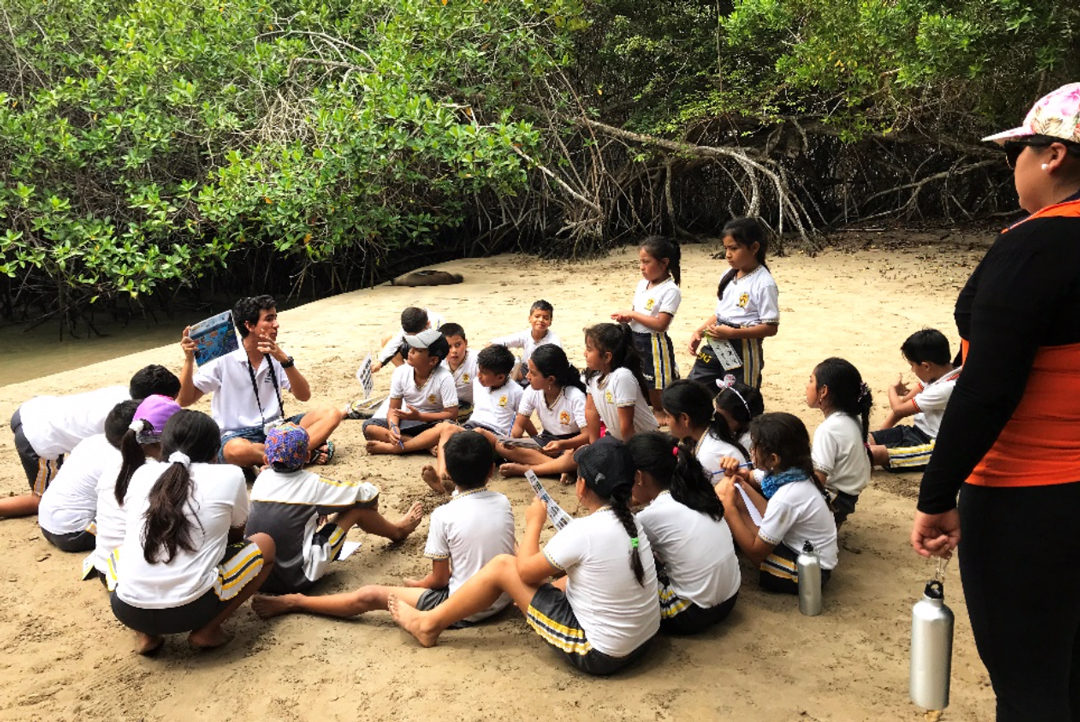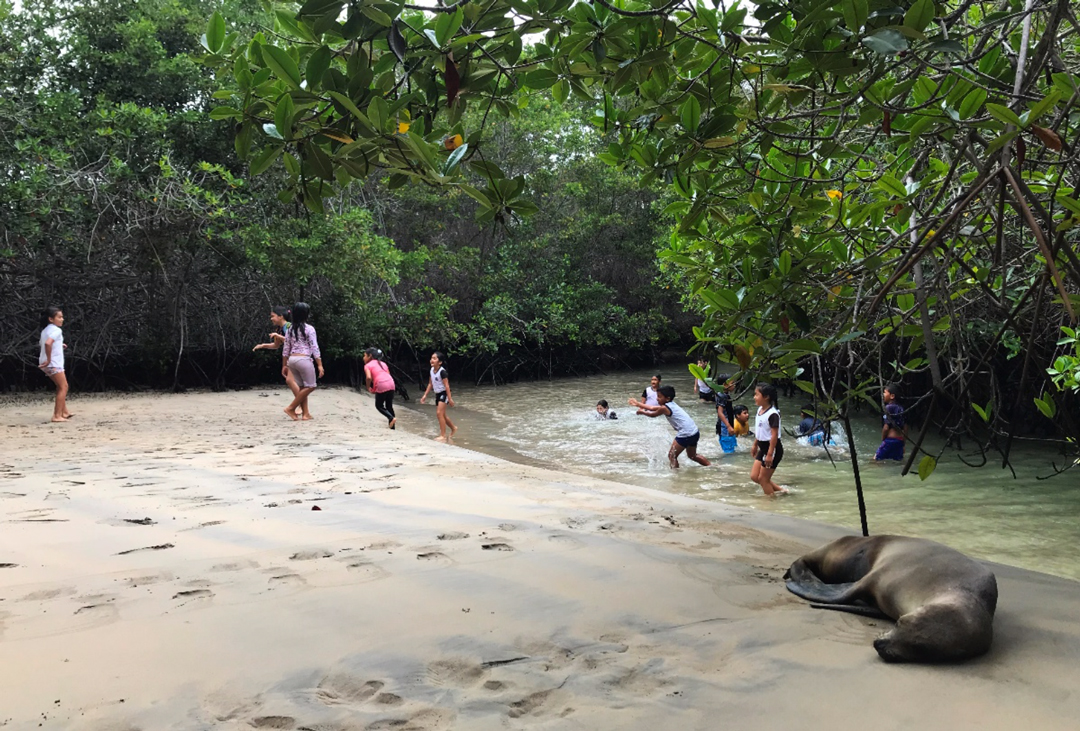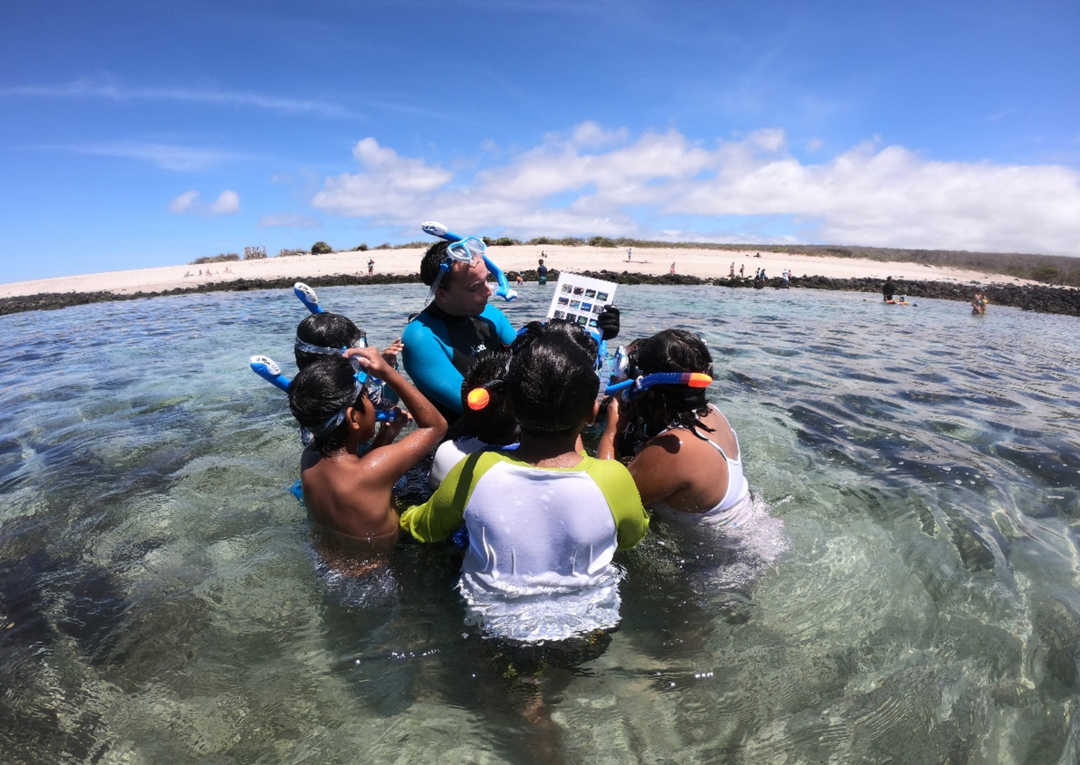Marine Mornings start in the schools in Galapagos

Students from the Alejandro Alvear school from San Cristobal observing agreen sea turtle in “La Lobería”. Photo © Daniela Vilema
Between October and December 2018, more than 1000 students from Santa Cruz, Isabela and San Cristobal Islands have participated in the “Marine Mornings” initiative, one of the components of our marine education project that takes place in Galapagos with the participation of the different schools. The students, together with their teachers, make observation field trips with our team to learn more about the marine ecosystems of the archipelago in the field. We cannot care of what we do not know, so the objective of this initiative is to invite the community to visit the beach more frequently to better understand the importance of protecting the oceans and their biodiversity.

Students from the Jacinto Gordillo school in Isabela learning about marine ecosystemswith Luis Cevallos, member of the marine education team. Photo © Daniela Vilema
The program in Santa Cruz consists of a tour in the Van Straelen Interpretation Center and the current Marine World exhibition, where children learn deeply about sharks, mangroves, marine invasive species and the impact of plastic on the oceans. Then, we go to “La Ratonera” beach where we can see different species of mangroves, invertebrates that live on the rocky shores, fish and many birds such as frigates, finches and blue-footed boobies. Following the line that marks the highest tide of the beaches in this area, we have found plastics of different sizes that we collect together to clean the beach and analyze how we can avoid marine pollution in our daily life.

Daniela Vilema, leader of the marine education project, teaching students about the speciesof sharks present in Galapagos. Photo © Luis Cevallos
Isabela, the largest island of the archipelago, received the designation of RAMSAR site in 2002 for its large area of wetlands. These areas harbor a large amount of life that includes fish, sea turtles, pelicans, invertebrates, marine iguanas, among others. Together with the students of the Odilo Aguilar, Jacinto Gordillo and Stella Maris schools, we visited the wetlands located on the way to the wall of tears, where the students had to identify all land and marine species during the walk-through coastal lagoons and “La Playa del Amor”, until getting to our final stop, “El Estero”. In this place, we analyzed the ecological roles of the different species and the children were able to enjoy a refreshing swim surrounded by mangroves and accompanied by a sea lion that was present every day of activities. In the afternoons, we went to “Concha de Perla” with older students, where we snorkeled, and we were able to observe a great amount and variety of marine life.

Students from the Stella Maris school from Isabela Island enjoying in “El Estero” after the walk through the wetlands. Photo © Daniela Vilema
San Cristobal, on the other hand, has several marine environments, but we decided to take the students to “La Loberia”, a visiting site to which I personally call it as a natural aquarium. This place is home to a lot of fish like yellow tail damsels, parrot fish, flag fish, sea turtles and a lot of sea lions. All the students were given a snorkel equipment and a buoy to those who had difficulty swimming. During the activity, we enjoyed a great visibility, we identified species and when we left the water, we could talk more about the different marine environments that can be found in the Galapagos Islands and their importance for animals and plants, as well as for people.

Students from the Alejandro Alvear school identifying fish in the species guide with Francisco Galvis, member of the marine education team. Photo © Daniela Vilema
The experience in water snorkeling has undoubtedly been a component that besides generating emotion in the children, has helped us to see the importance of committing ourselves as a community to take care of the place where we live. Seeing a turtle eating seaweed and swimming in a book is not the same as seeing it in person, as well as being able to swim with white tip sharks or swim with sea lions while doing pirouettes in the water; and in Galapagos we are lucky to live in a place that, being protected, allows us to enjoy these experiences. Soon we will be in Floreana to continue teaching more people about the conservation of the oceans and we hope that little by little through the students, teachers and parents that have participated we can motivate more people to join the conservation efforts of our archipelago.
Thanks to the Save Our Seas Foundation for their unconditional support on our Marine Education Project!
